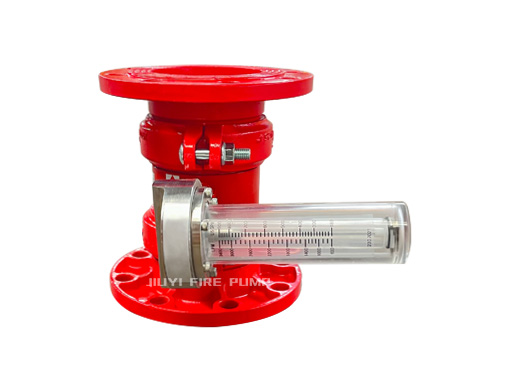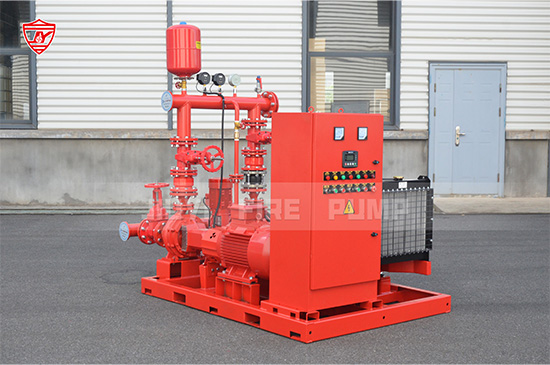In a building fire emergency, every second counts. While alarms, strobes, and evacuation protocols guide occupants to safety, one unsung hero operates in the background to contain the fire and prevent catastrophe — the fire pump.
Fire pumps are critical components of any fire protection system. These systems ensure that water is delivered at the necessary pressure and flow rate to suppress fire, especially in high-rise buildings or facilities with large square footage. In this article, we explore how fire pumps work during emergency evacuations, why they're vital to fire protection systems, and how they help save lives and reduce property loss.

What Is a Fire Pump?
A fire pump is a mechanical device that increases water pressure in a fire protection system. It is typically activated when the pressure in the system drops below a certain threshold, usually triggered by an open sprinkler head or a fire hose being used.
Fire pumps are required when the local water supply isn’t sufficient to meet the hydraulic design requirements of the fire suppression system — which is common in tall buildings or facilities with large water demand during fire emergencies.
How Fire Pumps Are Triggered During a Fire Emergency
Fire pumps are not manually activated in most systems. Instead, they are automatically turned on by a drop in water pressure.
Here’s how the process works:
-
Sprinkler Activation or Hose Valve Opens: When heat from a fire reaches a certain point, sprinkler heads activate. Alternatively, firefighters may open a hose valve.
-
Pressure Drop Detected: The sudden release of water causes a pressure drop in the system.
-
Controller Activates the Pump: The fire pump controller detects the drop and sends a signal to start the pump.
-
Pump Increases Pressure: The pump kicks in, drawing water from a water tank, reservoir, or underground source and boosting it through the system at high pressure.
-
Water Delivered to Sprinklers/Hydrants: Pressurized water reaches the sprinklers and hose valves, helping suppress the fire.
Types of Fire Pumps Used During Evacuations
Fire pumps come in several types depending on the building design and fire protection requirements:
1. Electric Fire Pumps
-
Powered by electricity
-
Require a reliable power supply or backup generator
-
Common in urban commercial buildings
2. Diesel Fire Pumps
-
Powered by a diesel engine
-
Ideal for facilities where electrical supply may be compromised
-
Self-sufficient with fuel storage
3. Jockey Pumps
-
Not used to fight fires directly
-
Maintain system pressure and prevent unnecessary fire pump activation
4. Vertical Turbine Pumps
-
Used where water source is underground or below pump level
-
Common in industrial or municipal applications
Each type plays a role in ensuring that, during an emergency evacuation, the fire suppression system works flawlessly to allow more time for safe evacuation.
Fire Pumps and Sprinkler Systems: A Vital Connection
During evacuations, sprinkler systems are the first line of defense to control the spread of fire. But sprinklers are only effective when they are supplied with enough water pressure. That’s where fire pumps come in.
Fire Pump Functions in Sprinkler Systems:
-
Maintain water pressure at 100–175 psi depending on system design
-
Provide water to the top floors of high-rise buildings
-
Ensure consistent water supply even when multiple sprinklers activate simultaneously
Without a functioning fire pump, the sprinklers could lose pressure and fail to contain the fire, endangering both occupants and firefighters.
Supporting Firefighter Operations
While occupants evacuate, firefighters enter the building. Fire pumps also provide the water pressure needed for standpipe systems, which firefighters use to connect their hoses on different floors.
This reduces the need for long hose lays from fire trucks outside, saving valuable time. Fire pumps:
-
Boost water pressure in standpipe systems
-
Allow multiple hoses to operate at once
-
Support firefighting on upper levels of buildings
A properly designed and tested fire pump system enables firefighters to fight fires more effectively, reducing overall damage.
How Fire Pumps Improve Evacuation Safety
1. Delaying Fire Spread
With high-pressure sprinklers active, the fire is kept in check, giving people more time to escape.
2. Preventing Flashover
By cooling the environment and fire load, fire pumps help avoid sudden combustion, known as flashover, which is deadly in confined spaces.
3. Assisting Rescue Teams
Clearer escape routes and reduced heat make it easier for rescue teams to reach people who are trapped.
4. Ensuring Redundant Safety
In buildings with multiple zones or risers, fire pumps ensure consistent pressure even if one section is compromised.
Redundancy and Backup in Fire Pump Systems
During emergencies, power can fail. That’s why fire protection codes (like NFPA 20) require redundant power sources and backup systems:
-
Diesel backup pumps if the primary pump is electric
-
Two independent power feeds
-
Emergency generators
This ensures the fire pump keeps running, even if the main power supply fails, which is a common occurrence during large fires.
Testing and Maintenance: Critical for Emergency Performance
Fire pumps are only valuable if they work when needed. Therefore, weekly or monthly testing is required by NFPA 25 (Standard for the Inspection, Testing, and Maintenance of Water-Based Fire Protection Systems).
Regular testing checks:
-
Automatic starting and stopping
-
Water flow and pressure
-
Controller function
-
Pump and engine condition
-
Valve positions
Well-maintained pumps ensure readiness in real-life emergencies.



